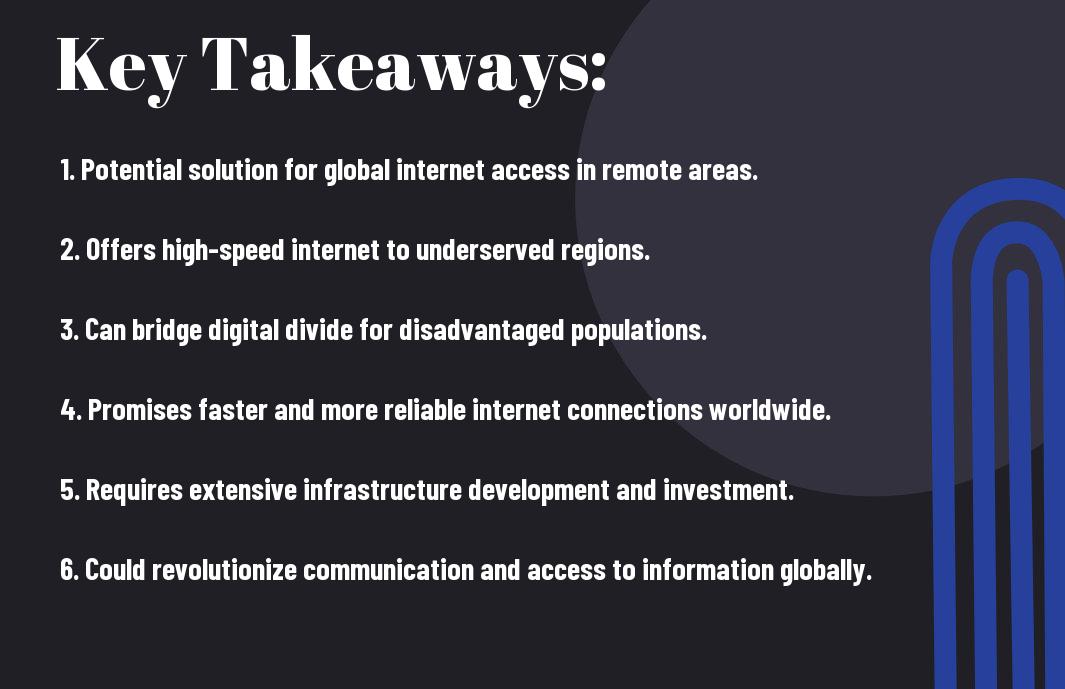Satellite technology has long been heralded as a potential game-changer in the quest for global connectivity. With billions of people still lacking access to the internet, the prospect of Space-based Wireless Internet Satellite sounds like a promising solution. This revolutionary approach could bridge the digital divide and bring the benefits of the online world to even the most remote corners of the globe. However, as we examine the possibilities and challenges of deploying an internet network from space, we must also consider the risks and implications that come with such a groundbreaking technology.
Key Takeaways:
- Global Connectivity Solution: Space-based wireless internet satellites have the potential to provide global connectivity, bridging the digital divide in remote and underserved areas.
- High-speed Internet Access: These satellites can offer high-speed Internet access to users worldwide, enabling seamless communication and access to online resources.
- Challenges and Considerations: While promising, the deployment of space-based internet satellites also presents challenges such as cost, regulatory issues, and sustainability concerns that need to be carefully addressed.

Evolution of Satellite Internet Technology
The evolution of wireless internet satellite technology has transformed global connectivity, offering high-speed, reliable internet access even in the most remote areas. This leap forward in technology ensures that no matter where you are, you can stay connected to the digital world.
– Early Beginnings and Progress
The beginnings of satellite internet technology can be traced back to the 1960s when the first communication satellite, Telstar 1, was launched into space. This marked the beginning of a new era in global connectivity, enabling long-distance communication through orbiting satellites. Over the years, advancements in technology led to the development of more sophisticated satellites that could provide internet access to remote areas.
Progress in satellite internet technology continued throughout the decades, with companies like HughesNet and Viasat pioneering the way for high-speed internet access via satellite. These early systems faced limitations such as high latency and limited bandwidth, but they laid the groundwork for the advanced satellite internet systems we have today.
– Current Advances in Satellite Internet
Internet satellites have undergone significant advancements in recent years, with companies like SpaceX, OneWeb, and Amazon investing heavily in low Earth orbit (LEO) satellite constellations. These new systems promise to revolutionize global connectivity by providing faster speeds and lower latency than traditional geostationary satellites.
Any global expansion opportunities are set to benefit from these advancements, bridging the digital divide and offering reliable internet access to underserved areas. With the potential to connect billions of people around the world, satellite internet is poised to play a crucial role in shaping the future of connectivity.
Read More: Will Space-based Wireless Internet Satellite Be The Answer To Global Connectivity?
Implementation of Space-based Internet Satellites
Your blog post takes a deep look into the potential of space-based internet satellites to revolutionize global connectivity. As we explore the implementation of these satellites, we’ll uncover the leading providers, their missions, technical challenges, and operational solutions.
– Leading Space Internet Providers and Their Missions
Space-based internet providers like SpaceX with its Starlink project and OneWeb are at the forefront of the race to connect the world using satellite technology. SpaceX aims to provide global internet coverage using a constellation of thousands of small satellites, while OneWeb focuses on bridging the digital divide by bringing internet access to underserved areas.
– Technical Challenges and Operational Solutions
Space-based internet satellites face technical challenges such as bandwidth limitations, signal latency, and orbital debris management. One of the critical operational solutions to these challenges is the deployment of advanced signal processing technologies to optimize data transmission and reception, ensuring reliable internet connectivity for users around the globe.
Plus, the coordination of satellite orbits and frequencies among different providers is crucial to prevent signal interference and ensure seamless connectivity for users. As the space-based internet industry continues to evolve, innovative solutions and collaborations will be crucial to overcome these technical challenges and deliver reliable internet access to every corner of the world.

Impact on Global Connectivity
The impact of advancements in global connectivity has been profound, reshaping communication, commerce, and information access worldwide. Enhanced internet infrastructure, including wireless and satellite technologies, has bridged the digital divide, connecting even the most remote regions to the global network. This unprecedented level of connectivity has fueled economic growth, fostered cultural exchange, and democratized access to knowledge and resources, ultimately transforming the way we live, work, and interact on a global scale.
– Accessibility and Coverage Benefits
Unlike traditional internet infrastructure that relies on cables and physical connections, space-based wireless internet satellites have the potential to revolutionize global connectivity. One of the primary benefits is the vast increase in accessibility and coverage that these satellites can provide. The reach of satellite signals can extend to remote regions and developing countries that lack proper infrastructure for traditional internet services.
Furthermore, by leveraging the vast expanse of space, satellite-based internet can offer seamless connectivity to users across oceans and mountainous terrains where laying physical cables is impractical. This technology has the capacity to bridge the digital divide and bring the world closer together in terms of communication and information access.
– Economic and Social Implications
Implications of space-based wireless internet satellites extend beyond just connectivity. One of the most significant advantages is the potential economic and social impact they can have on communities worldwide. By enabling internet access in previously underserved areas, these satellites can unlock new opportunities for education, entrepreneurship, and innovation.
The increased connectivity can also lead to enhanced communication networks, improved disaster response mechanisms, and better access to necessary services such as healthcare and banking. The societal benefits of a globally connected world are immense, paving the way for a more inclusive and empowered global population.
Implications for the economy include the stimulation of new digital economies in regions that were previously isolated, fostering growth and development. Additionally, increased internet access can lead to a more informed and educated workforce, driving productivity and competitiveness on a global scale.

Future of Space-based Internet
To meet the growing demands for global connectivity, the future of space-based internet holds immense promise. With advancements in technology and regulatory frameworks, satellite-based internet services are poised to revolutionize the way we connect and communicate on a global scale.
– Emerging Technologies and Innovations
Any discussion on the future of space-based internet must acknowledge the role of emerging technologies and innovations in shaping the landscape. From the development of advanced satellite constellations to the use of high-throughput payloads, the industry is constantly evolving to enhance coverage, capacity, and efficiency.
Moreover, the integration of artificial intelligence and machine learning algorithms is paving the way for smarter and more adaptive satellite systems. These technologies not only improve network performance but also enable proactive monitoring and seamless connectivity across remote regions.
– Legal, Regulatory, and Security Considerations
With the expansion of space-based internet services, legal, regulatory, and security considerations play a crucial role in ensuring the safe and responsible use of satellite technology. Regulatory bodies must establish frameworks to govern spectrum allocation, orbital debris mitigation, and cross-border interference issues.
Technologies such as quantum encryption and secure data transmission protocols are imperative in safeguarding space-based internet networks against cyber threats and malicious activities. Adhering to international treaties and standards is crucial to fostering trust among stakeholders and promoting the sustainable development of space-based internet infrastructure.
Conclusion
Now, with the advancement of technology and the launch of space-based wireless internet satellites, there is hope for a more connected world. These satellites have the potential to provide internet access to remote and underserved areas, bridging the digital divide and offering opportunities for education, communication, and economic growth. While challenges remain, such as cost and infrastructure, the future looks promising for global connectivity through space-based technology.
Read More: The Power of the Future Artificial Intelligence and Machine Learning
FAQ
Q: What is space-based wireless internet satellite technology?
A: Space-based wireless internet satellite technology involves using satellites in space to provide internet connectivity to users on Earth. These satellites act as relay stations, transmitting internet signals to and from the ground, allowing for global connectivity.
Q: How will space-based wireless internet satellite technology improve global connectivity?
A: Space-based wireless internet satellite technology has the potential to reach underserved and remote areas that traditional terrestrial infrastructure cannot reach. This technology can bridge the digital divide by providing high-speed internet access to regions without reliable connectivity, thus improving access to information, education, and economic opportunities globally.
Q: What are the challenges and limitations of space-based wireless internet satellite technology?
A: Some challenges of space-based wireless internet satellite technology include high costs associated with satellite deployment and maintenance, latency issues due to the distance signals must travel between Earth and satellites, and concerns about space debris and interference with other satellite communications. Additionally, regulatory hurdles and competition with other internet connectivity technologies can impact the widespread adoption of this technology.
*****************************

